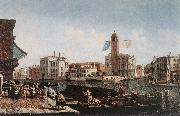|
|
|
|
|
MARIESCHI, Michele
|
|
The_Grand_Canal_with_the_Fishmarket_sg
|
|
c._1740
Oil_on_canvas,_55_x_82_cm
Private_collection
|
|
|
|
|
|

|
|
Click to Enlarge
|
| MARIESCHI,_Michele
|
The Grand Canal with the Fishmarket sg
MARIESCHI, Michele2.jpg
|
|
|
|
|
|
| c. 1740
Oil on canvas, 55 x 82 cm
Private collection |
|
|
Italian Painter, 1710-1743
Italian painter and engraver. His first biographers, Orlandi and Guarienti (1753), stated that Marieschi worked in Germany early in his career and then returned to Venice, where he established himself as a painter of 'beautiful views of the Grand Canal, and of churches and palaces'. Yet there is no other evidence for this journey and Marieschi's early training remains problematic. It seems likely that he began his career as a stage designer: his first recorded activity, in 1731, was the preparation, on behalf of the impresario Francesco Tasso ( fl 1725-c. 1740), of the setting for the Venetian celebration of Carnival Thursday in the Piazzetta. He then, influenced by Marco Ricci and Luca Carlevaris, began to paint capriccios and vedute. His early capriccios, such as the pair Capriccio with Classical Ruins and Bridge and Capriccio with Roman Arch and Encampment (mid-1730s; Naples, Mus. Civ. Gaetano Filangieri), are indebted to Ricci, although they lack his solemnity and magnificence. Marieschi's blend of medieval and Classical ruins in a serene Venetian landscape is more picturesque and romantic. Marieschi began to paint vedute having been encouraged by Canaletto's great success with the genre; examples such as the S Maria della Salute (1733-5; Paris, Louvre), the Piazzetta dei Leoni and the Grand Canal at Ca' Pesaro (1734-5; both Munich, Alte Pin.) are distinguished from Canaletto's work by their exaggerated perspective, more atmospheric colour and the spirited handling of the small figures. Two capriccios, the Town on a River with Rapids (London, N.G.) and the Town on a River with Shipping (London, N.G.;.), both charmingly picturesque scenes with watermills and crumbling towers, date from the mid-1730s. Marieschi began to etch in the 1730s,
|
|
|
|
|
|
|